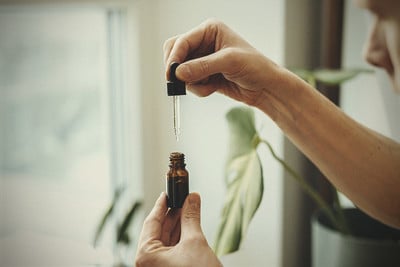.

CBD Tinctures: What You Need to Know & How to Make Your Own
With all the CBD products on the market, it can be hard to choose the right one for you. Tinctures, oils, capsules, topicals: what's the difference? Let us demystify the world of CBD, starting with tinctures. Plus, we'll give you a simple recipe for making your own CBD tincture at home.
Understanding CBD tinctures.
Contents:
CBD can be taken in many ways, from smoking a high-CBD strain to ingesting CBD capsules or edibles. The plethora of options can be overwhelming, even for seasoned aficionados. Here we'll focus on CBD tinctures: what are they, what are their benefits, and how can you make a CBD tincture at home? Here's everything you need to know.
What Are CBD Tinctures?
Tinctures are highly concentrated herbal extractions. They come in liquid form and are typically administered a few drops at a time. Cannabidiol (CBD) tinctures are created by steeping CBD-rich hemp flowers in high-proof grain alcohol. Vinegar or glycerine can be used in lieu of alcohol, but alcohol really does produce the best tincture in the end. The process is time-consuming, but very simple.
CBD tincture should be potent, with a very high CBD content, and contain no more than 0.3% tetrahydrocannabinol (THC). This is different from cannabis tincture, which contains THC and other cannabinoids. Since CBD is not psychotropic, CBD tincture won't get you high. However, it has plenty of other benefits.
Is CBD Tincture the Same as CBD oil?
CBD tincture and CBD oil share a lot common:
- Both are liquid concentrates of CBD and have similar properties and effects once ingested.
- You can often find both of these products packaged in small bottles.
In some cases, manufacturers will even label CBD oils as "CBD oil tincture", causing understandable confusion when you're trying to sort through the different products on the market. However, there are some key differences between CBD oil and true CBD tincture:
- Tinctures are made with raw hemp material infused into a base of alcohol.
- CBD oils are made by infusing CBD isolate into a carrier oil, such as olive oil, hemp seed oil, or MCT oil.
Their alcohol base gives CBD tinctures a few advantages:
- Tinctures have a longer shelf-life than oil-based products.
- Because they are water soluble, CBD tinctures are easy to add to food and drink.
- Tinctures have higher bioavailability. That means the CBD in tinctures is more readily absorbed by the body.
If DIY is your thing, CBD tinctures are also very easy to make at home.
Homemade vs Shop-Bought CBD Tinctures
So, how exactly do you make a CBD tincture at home? And how are homemade tinctures different from what you would buy commercially?
Commercial CBD Tinctures
Commercial CBD tinctures are usually made using either an alcohol or CO₂ extraction method. The latter creates a highly purified CBD isolate that is then infused into a carrier base, often an oil.
As a result, many commercial CBD products labelled as "tinctures" are actually oils. While these oil-based products don't meet the technical definition of tincture, the term gets used to market any highly concentrated CBD extraction that comes in a dropper bottle and can be taken sublingually. It also distinguishes oil-based "tinctures'' from other CBD oil products that are meant to be used differently.
Quality commercial CBD tinctures offer convenience and high levels of purity. Oil-based tinctures that use a CO₂ extraction method are often extremely potent.

Homemade CBD Tinctures
Homemade CBD tinctures are made by soaking hemp or cannabis plant material in alcohol. The alcohol may or may not be heated to encourage extraction. Vinegar or vegetable glycerine can be used instead of alcohol. However, alcohol will give a more potent result.
Homemade tinctures are not as pure as commercial tinctures, which use industrial methods to remove impurities during the extraction process. However, homemade CBD tinctures are less expensive and afford more control over ingredients. Making a homemade tincture allows you to choose your preferred strain of cannabis. It also lets you adjust the potency as desired.
How to Make a Homemade CBD Tincture
A few simple ingredients and some patience are all you need to make a CBD tincture at home. Here's an easy recipe to get you started.
Ingredients and Hardware
- Mason jar
- High-proof grain alcohol (at least 60–70%)
- Strainer
- Tinted dropper bottle
- High-CBD cannabis flower or concentrate
Instructions
- If you're using cannabis flower, start by decarboxylating your weed. But, be judicious when choosing a strain. If you use a strain of cannabis that contains high levels of THC, your end product will be psychotropic. For a pure CBD tincture that won't get you high, stick with a strain that has little-to-no THC in it.
- Mix your decarboxylated flower or concentrate with the alcohol in a mason jar. The higher the proof, the better the alcohol will extract the CBD. You should use about one 750ml jar of alcohol for every ounce (28g) of cannabis.
- Seal the jar and let the mixture sit for a few weeks, preferably in a dark place. Exposure to light can break down the active compounds. This will decrease the tincture's potency.
- Shake the jar once per day.
- Strain your mixture and shop it in a tinted dropper bottle.
- To save time, you can simmer the cannabis and alcohol mixture over low heat for a few hours. If you want a more potent result, you can decrease the ratio of alcohol to cannabis. Just be careful if you decide to apply heat. Remember, you're working with flammable ingredients.
How to Use CBD Tinctures
CBD tinctures are highly concentrated, so a typical dose consists of just a few drops. Many users find that tinctures are ideal for microdosing CBD. If you want a stronger effect, simply add more drops.
Tinctures tend to be bitter. You can mask their bitterness by adding them to food and drink. Try adding a few drops of your CBD tincture to soup, salad dressing, coffee, or tea.
If the bitterness doesn't bother you, you can take your tincture sublingually (under the tongue). Research suggests that substances taken sublingually are absorbed by the body faster[1] than other oral methods.
When dosing a CBD tincture, hold it under your tongue for at least a minute. This will allow it to enter your bloodstream. You should start to feel the effects in around 15 minutes.

Can You Use Oral CBD Oil or Tincture Topically?
CBD tinctures are meant to be taken orally, but some people use them topically. While there's nothing really wrong with this practice, it's not the most effective use of your product. Topical CBD products usually contain other ingredients that are beneficial for your skin. They are also formulated for absorption through the skin. If you need a topical, it's best to search for an oil, gel, or cream that's designed for this type of application.
What Are the Benefits of CBD Tinctures?
When using CBD tinctures, many people report relaxing or rejuvenating effects. Tinctures offer all the benefits of CBD in a discreet, easy-to-consume format. They don't need to be smoked or vaporized, and they can be easily added to food or administered under the tongue. The dropper bottles themselves are very small, making them easy to conceal in a purse or pocket. Because tinctures are taken a few drops at a time, it is easy to adjust your dose with precision.
Is CBD Tincture Legal?
Since CBD is non-psychotropic and won't get you high, it is legal in most places. Of course, it's always best to check your local laws. Generally, if your CBD tincture is made with hemp (which contains little-to-no THC), you shouldn't have a problem. According to the World Health Organisation (WHO), CBD is not addictive, and is generally safe and well-tolerated.
Should You Try CBD Tincture?
If you want to experiment with CBD, consider trying a tincture. It's a great option if you don't want to smoke or vape your CBD. Discreet and easy to dose, tinctures are perfect for novice users and CBD connoisseurs alike. Find a good CBD tincture commercially, or make your own at home.
- HuffPost is now a part of Verizon Media https://www.huffpost.com
- https://www.cibdol.fr/blog/461-pourquoi-cibdol-est-pris-sous-la-langue









































